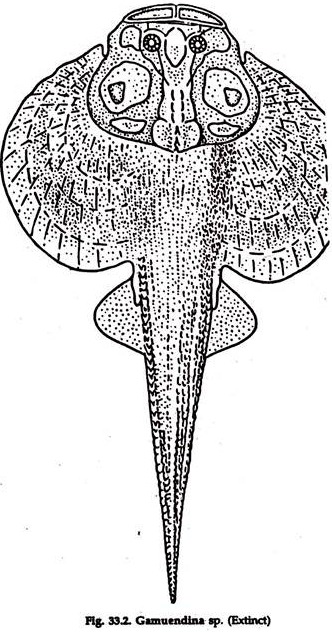In this article we will discuss about the classification of class placodermi.
Classification of Class Placodermi:
Placodermi are the earliest jawed vertebrates, appeared in the Silurian periods, flourished in the Devonian and Carboniferous and became extinct in the Permian. They had ‘heavy defensive armour and hinged jaws.
The hyoid arch did not support the jaw (the aphetohyoidean condition) indicating that autostylic jaw suspension is more primitive than that in any other jawed animals. Their paired fins were essentially adaptive organs.
ADVERTISEMENTS:
Classification: Class Placodermi:
Subclass Acanthodii:
Acanthodii or “needle-finned sharks” are oldest and least specialized known gnathostomes, which became extinct in the Lower Permian. They were fresh water, superficially shark-like, elongated fish with blunt snout, heterocercal tail and series of paired fins between the pectoral and pelvic fins.
Examples: Climatius, Acanthodes, etc.
ADVERTISEMENTS:
Subclass Arthrodira (Coccostei):
Arthrodira are allied to elasmobranchs with the head protected by bony plates which are united to form a strong cranial roof. The remaining free part of the body tapered to a whip-like tail and was either naked or in some covered with scales. They were fast swimmers and predatory forms with an operculum covering the branchial arches.
Examples: Arctolepis, Coccosteus, Mylostoma, Dinichthys, etc.
Subclass Petalichthyida:
ADVERTISEMENTS:
Devonian forms allied to elasmobranchs. The structure of shoulder girdle, the tribasal pectoral fin, is similar to earlier elasmobranchs. Ventral position of mouth and flattening of neurocranium were the result of adaptation to bottom dwelling.
Examples: Macropetalichthys, (Fig. 33.1) Lunaspis, etc.
Subclass Antiarchi (Pterichthyomorphi):
Devonian, small, freshwater forms, sufficiently well preserved specimens reveal certain internal details. Spiral valve, backwardly directed sacs like lungs, communicating with the pharynx, were present. Mouth ventrally placed, eyes closely placed on the dorsal side of head and tail covered with scales.
Examples: Bothriolepis , Microbrachius, Ceraspis, etc.
Subclass Rhenanida:
Devonian placoderms with dorsoventrally flattened body and broad head, like rays. Bony plates constitute the body armour which are provided with small denticles. The skull fully ossified. The gills are covered by operculum. Spiracle absent. Pectoral fins large and are supported by elongated radials.
Examples: Gemuendina (Fig. 33.2) Asterostens, gagorina, etc.
Subclass Palaeospondylia:
The group having dorsoventrally depressed skull and well-ossified vertebral column. The vertebrae on the posterior side possess strong central with neural arch and haemal spine. Tail heterocercal. Auditory capsule large. Traces of paired fins present. The hyoid arch complete but never takes part in jaw suspension. The external armour is complete.

